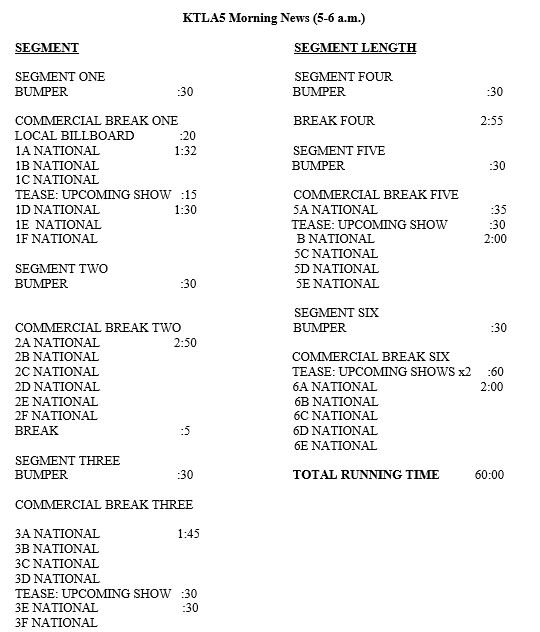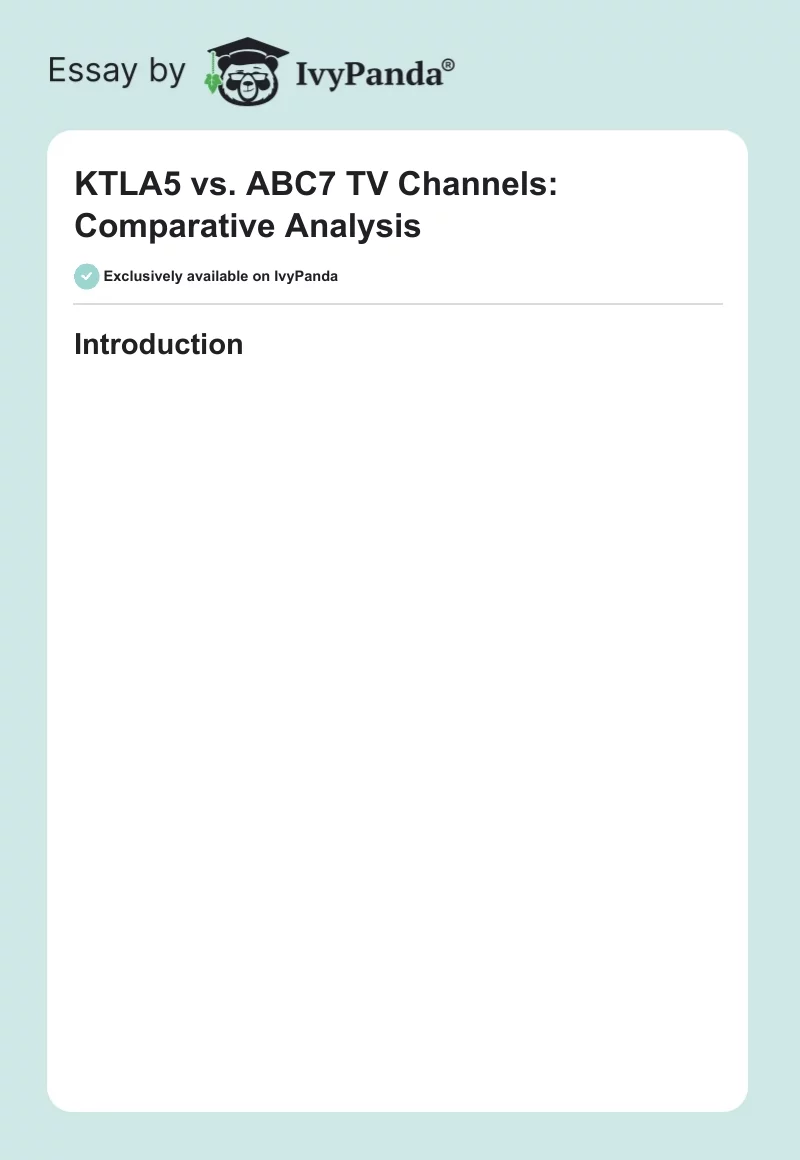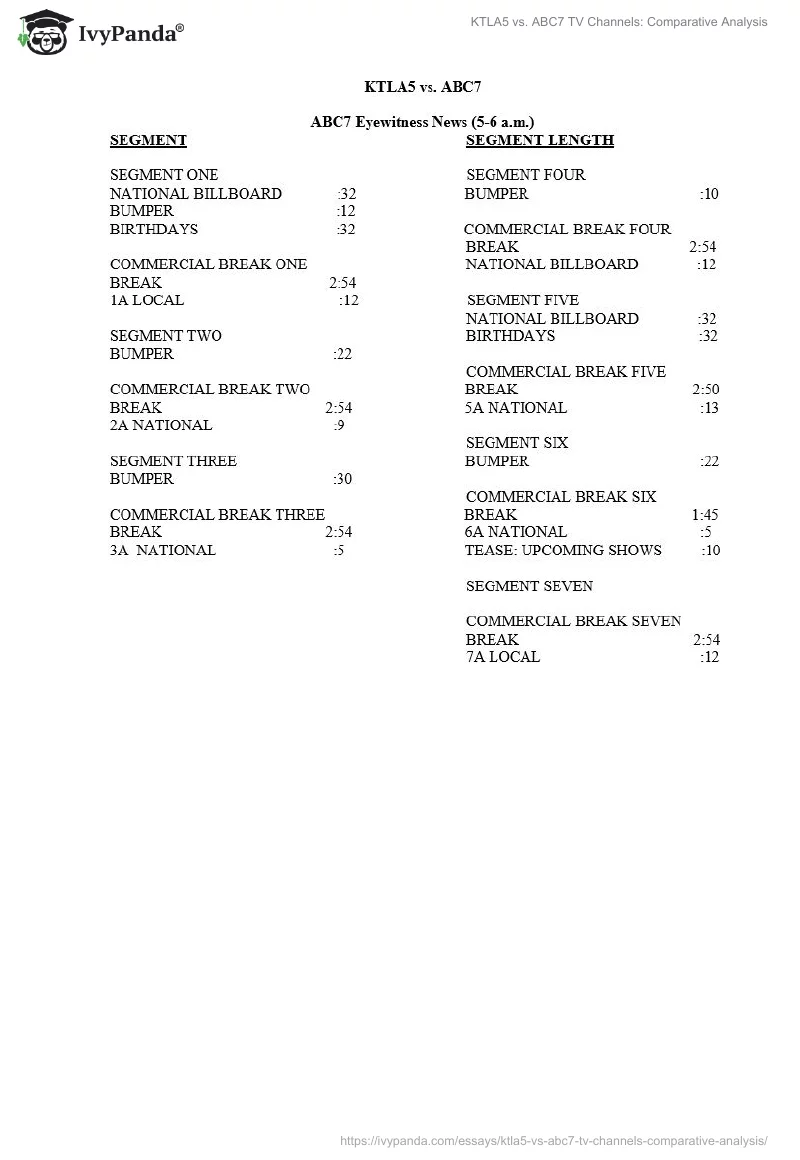Introduction


Two local stations, KTLA5 and ABC7, were selected for the analysis. Both of them offer their audiences morning news programs with a duration of over an hour. KTLA broadcasts Morning News from 4-11 a.m., whereas ABC7 runs Eyewitness Morning News from 4 till 7 a.m. Both stations organize their morning broadcasting schedule in a similar manner. The airtime is divided into uneven content sections, which, in turn, are separated by commercial breaks. Furthermore, the further division has been observed within the advertisement, showing both nationwide and local products. For this assignment, the same one-hour-timeframe of both newscasts on the same day has been watched to identify commercial/promo/PSA loads. While the stations were observed live, the nature of the assignment required a further examination of the content. As such, the newscasts were recorded in order to ensure detailed documentation of the schedules. This way, it was possible to observe the entire timeline of both newscasts and commercial breaks, which enabled a better understanding of the required concepts. The syndicated format was used to determine the exact schedule of advertisement and load quality.
Evaluation
According to the syndicated table, ABC7 divided an hour of Morning News into seven different segments and seven commercial breaks. Interestingly, these segments and breaks vary in terms of their duration. For example, the second segment is three times as short as the first and the third ones, whereas the sixth commercial break was revealed to be the shortest. At the same time, every break contains at least one national or local ad. For example, ABC7 advertises Cerritos Auto Square (automobile retail center), FORD, and Chevrolet in short (0:5-0:15) cuts. Other short ads represent medicines such as Dupixent, which is available to the nationwide general audience.
Furthermore, some breaks (commercial break six) end with a promo of upcoming shows, including the Tamron Hall talk show. The station uses so-called bumpers of different lengths almost after every news segment to inform viewers about the upcoming coverage. Twice in an hour, the break is followed by a birthday segment that congratulates children on their birthdays. Another interesting aspect comprises the Jacoby & Meyers’s (local law firm) billboard embedded into the traffic map. It resembles the native advertising technique that does not need a commercial break and blends ads into the actual content. Personal observations suggest that the audience is more likely to switch the channel when explicit advertising appears, whereas native formats prove to be more effective in terms of viewer engagement.
The second syndicated table reveals that Morning News’s hour is split into six segments with six commercial breaks. As it can be seen, every segment ends with a 30-second bumper showing the upcoming content. The bumper is followed by a three-minute ad break that consists of seven different cuts. The observation indicated that most of the breaks are dedicated to various charity foundations, social campaigns/movements, and related organizations that operate on the national level.
For instance, the break load includes advertisements for the American Red Cross, Tory Burch Foundation, Literacy Foundation, Heifer International, Fatherhood.gov, Wounded Warriors Project, and Disaster Checklist. In this case, the majority of mentioned ads may be PSAs. It means that the channel does not generally charge the charity for the spot or fill unsold ad space. In addition, charity organization advertisements positively affect the image of the station, reinforcing its perceived commitment to noble goals. On the contrary, the ads of UBER and News Nation Now are clearly commercial. What is more, breaks include at least one promo of upcoming TV series or shows such as All American by Netflix and LA Morning News. Teases are longer than ABC7’s ones and last for thirty seconds on average.
Comparison
Both channels limit their commercial loads during newscasts, especially in the morning. ABC7 dedicated slightly more time to ad breaks than KTLA5 during the morning news. Nevertheless, ABC7 airs only a few commercials and hides others, while KTLA5 transforms its commercial load into a PSA load. It means that the latter advertises more organizations, products, and services but may still receive less income. In order to identify the more successful of the two stations in terms of perceived income, the main advertised products should be compared.
Even if charity organizations pay for the spot, they are usually charged a lower rate than other enterprises. On the contrary, wealthy companies are expected to pay at least $34.75 per thousand viewers in Los Angeles if they want to air their 30-second commercial (Main, 2021). The price depends on the channel’s status, the time of the day (higher in the evening), and audience size and quality. ABC7 is known as the most-watched TV station in Southern California; thus, it should have a higher price for commercial ads compared to rates of KTLA5. For that reason, although ABC7 streams less ad content during the news breaks, it still outperforms KTLA in terms of income. It promotes products of influential automakers (Ford and Chevrolet), law firms (Jacoby & Meyers), and pharmaceutical companies. Such organizations are associated with considerable resources, which translates into larger marketing budgets. On the contrary, KTLA5 possesses a large PSA load that encourages people to be active and empathetic to those in need. While such publicity is positive in terms of the public image, it is less effective, as far as financial benefits are concerned.
In conclusion, the examination revealed that the stations under review follow similar patterns in terms of organizing their morning broadcasts. Both of them include both national and local commercials in the schedules, but the former prevails in terms of airtime. This tendency is understandable since nationwide companies operate considerable budgets, allowing them to launch wider-scope campaigns. However, despite the observed similarities, KTLA5 showed a significantly higher level of PSA load. As such commercials are less profitable for television networks, it is possible to conclude that ABC7 performs better in terms of the perceived advertisement income.
Reference
Main, K. (2021). Everything you need to know about TV advertising costs. Fit Small Business. Web.


